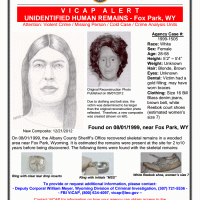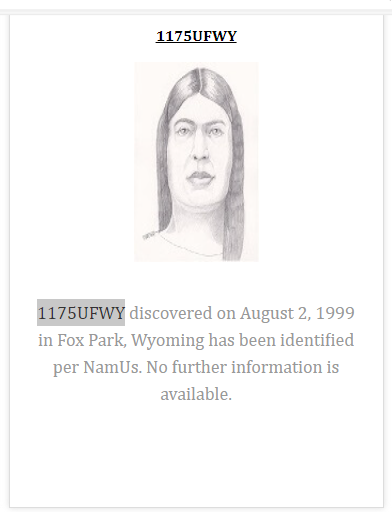http://z13.invisionfree.com/PorchlightUSA/ar/t19389.htm
http://www.laramieboomerang.com/articles/2...31947418803.txt
Detective's probe into unidentified women means putting puzzle pieces together
By JOSHUA ROBERTS
Monday, December 24, 2012
It's August 1999 and a Cheyenne man is hiking the area around Fox Park, a small mountain town southwest of Laramie.
His walk unearths a startling discovery - a human skull.
It's September 2010, near Roger Canyon Road, when a sheepherder working for an area livestock company stumbles upon the remains of a woman's body.
Neither of the investigations yield much information.
A search of the scene for more about Jane Doe 1999 produces additional skeletal remains, two rings, Reebok tennis shoes and stray bits of clothing.
She's believed to be 5'2-5'4 inches tall, with a 36-38-inch waist and anywhere from 24-58 years old.
Investigators believe she could have died as many as 10 years before.
Jane Doe 2010 was believed to be smaller, 5'2-5'4, 105-120 pounds and between 30 and 50 years old. She could have died as early as fall 2009.
Information dries up.
Time moves on.
The cases go cold, the women remain unidentified.
It's unlikely Bill Meyer, a detective corporal with the Albany County Sheriff's Office, ever met either of the women, but it's his job to learn everything he can about them.
He reopened the probes in March 2011, shortly after being promoted to detective, looking for ways to fill downtime between current cases.
Through his efforts, with assists from numerous other sources, he said, he was able to identify Jane Doe 2010 as Rosella Lovell, a former Laramie resident and University of Wyoming janitorial staffer, earlier this year.
Jane Doe 1999's real identity remains unknown. Untangling who she was presents more challenges than Lovell�s case, the detective said.
I have no idea how to gauge it, he said. You look at the Lovell case. I had done so much on that for over a year and that doesn't include what took place with her in 2010. All it took was a couple of tips.
I think this one's going to be a little bit harder because of the timeframe. With this woman, we just don't know. She could be from anywhere in the world.
But, challenging doesn't equal impossible.
When I reopened both of these cases, I came to the realism, because of the time frame, the conditions of the bodies when they were discovered and the lack of evidence, that I may not solve a crime, but I might be able to at least identify them, Meyer said.
If I had a loved one that was one of these women, I would want to know.
Meyer, 31, a Laramie native, is a detective corporal with the Sheriff's Office, a veteran of the agency since 2002 and its sole investigator.
His career arc entails a two-year stint as a deputy at the Albany County Detention Center, five years in patrol, a brief period with a regional task force, back to patrol and eventually to a landing spot as detective.
He's perhaps found his niche with investigations.
Immensely, he said when asked whether he enjoys his work. I like the fact that with any case the whole goal is to take all the puzzle pieces and make one big picture.
When you're doing the legwork and you're starting to get all those pieces and you're forming the case and what took place, it's rewarding and enjoyable to try and put all that together.
Meyer, a 1999 Laramie High School graduate, didn't initially earmark law enforcement as a career, though the profession is in his DNA, like a family trait.
As a high schooler prepping for college, he thought he'd become a welder. A serious injury his senior year, however, made long hours in a shop impractical.
He then turned to law enforcement.
His father, Bill, Sr., began his law enforcement career with the Sheriff's Office before transitioning to the Laramie Police Department. He retired in 2005.
The younger Meyer enrolled at Eastern Wyoming College in Torrington and earned an associate's degree in criminal justice.
He has family members currently working for the Sheriff's Office and LPD.
I fell into criminal justice, but I enjoyed all those aspects, he said. It appealed to me and it's kind of been a way of life for us.
A turning point in his career with the Sheriff's Office came in May 2008, when he was detailed to the regional task force, primarily working felony drug cases.
It gave me the ability to sharpen my skills with search warrants, affidavits of probable cause, district court stuff, federal court stuff, he said. It was in the realm of everything.
As soon as this investigator's position opened, I determined that I enjoyed the stuff I did as a task force officer, I had a lot of the skills, so I thought this was something I would enjoy.
A Laramie product born and bred, Meyer said he's likely to stick with the Sheriff's Office for the long haul, growing within the department in whatever role he's most useful.
For now, investigations are a good fit, he said, offering a variety of cases.
Outside of the Jane Doe probes, his current caseload includes check fraud, suspicious death, sexual assault, felony animal cruelty and digging into a recent marijuana seizure at Laramie Regional Airport.
I don't know what's going to come down the road, but I've been here (as a detective) for two years now and I am still enjoying it, he said.
Inevitably, Meyer's work brings him back to the Jane Does.
The Sheriff's Office, like any law enforcement agency, has an assortment of unsolved crimes, mostly in the way of larcenies or burglaries, but Meyer describes the 1999 and 2010 women as the most substantial.
There are investigative advantages this time around, he said, edges that weren't available when they were originally probed.
I think a reason that these sat cold for a long time was because all the resources were expended back then, Meyer said. I realized, and this was all new to me, I was new to even being a detective at the time, that things like (the National Missing and Unidentified Persons System) were available and databases and I was going to get DNA information.
Meyer, an avid outdoorsman, compares his investigative approach on the Jane Doe cases to fishing.
The more bait dangled, the better the likelihood of getting a nibble.
I realized all of it was a long shot, but the more things I had that were reaching out, looking for other avenues, the higher probability I had to identifying them, he said. Now it's kind of a waiting game to see if what I threw out there in the world is going to come back to me and give me a good lead or not.
Though Jane Doe 2010 has been identified as Lovell a memorial service took place this fall in Laramie for her friends and family to pay respect there remain unanswered questions about the circumstances of her death.
Jane Doe 1999 is a complete mystery.
Meyer has the rings: they appear to be unique and one of them includes the engraved initials, M.S.S. He has the tennis shoes: the crime lab was able to determine the year they were manufactured and sold.
He has a potential lead: a missing woman from Tennessee. She fits the age range, shares the same initials on the ring and the detective has asked for a DNA comparison.
The woman, her husband and their vehicle vanished in 1972, Meyer said, and they were never heard from again.
And, he has technology, bait dangled into the far reaches of cyberspace, a wide net waiting for the nibble that can make the difference between Jane Doe and case closed.
We've done what we could with every little thing we have, he said. With every little piece of evidence, we try to look at all the avenues.
The Lovell case loosened when community members identified her through a facial reconstruction published in the newspaper.
A small break is sometimes all it takes, Meyer said.
The day I got the tip on Ms. Lovell, I spent the next two days and into the afternoons and nights following leads because they felt like fresh leads, he said. You do an interview, you get a lead. You do another interview, you get one more lead.
Within 24 hours, I learned it could be a woman named Rose. I was able to build a victimology on her, I was able to get to know her and what her life was. That's what I enjoy taking those pieces and running with them.


 www.crimewatchers.net
www.crimewatchers.net







